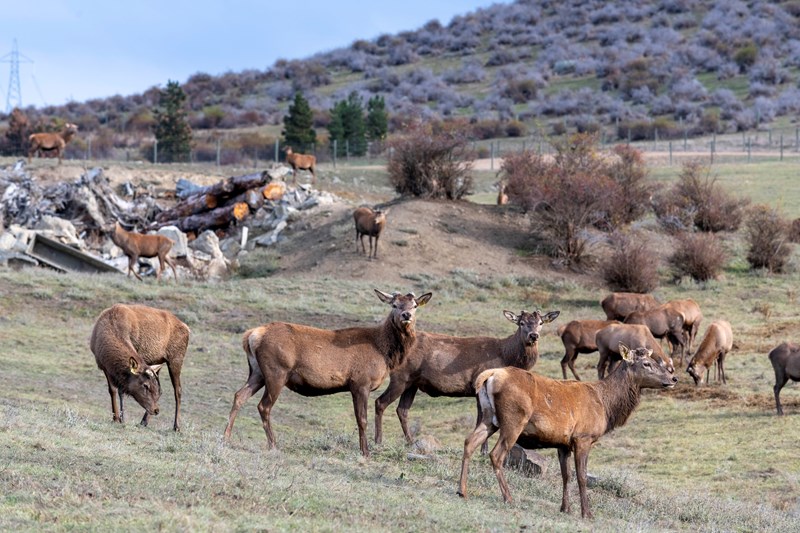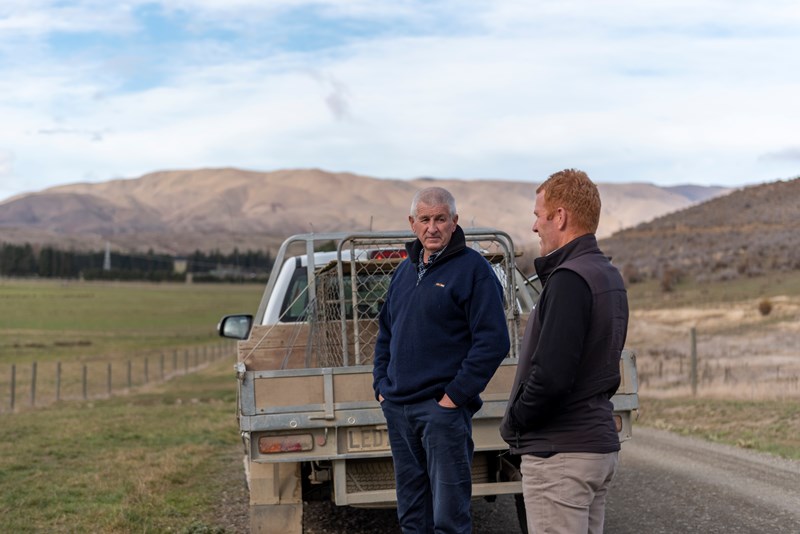Tuesday, 9 August 2022
Adoption and progression at Haldon Station: the heart of the Mackenzie
Written by Lynda Gray
The ability to grow grass under pivot irrigation has been a game changer for Haldon Station in South Canterbury’s Mackenzie Country.
Feeding, breeding and irrigation have combined in the building of a successful deer finishing system in the extreme climate at Haldon Station. But after 40 years of farming them, deer are still a work in progress for long-time manager and Ravensdown shareholder Paddy Boyd.
The move to weaner finishing was enforced after a brush with Tuberculosis (Tb) back in the mid-1980s. Up until then, progeny from the 2,000 breeding hinds were either sold on for finishing or finished on farm over two years. It was a simple no-fuss system that suited the extensive briar and hill and semi-developed lower-lying hill country typical of the Mackenzie Basin.
But that went by the wayside when Tb testing turned up 15 reactors.
“It was a low percentage of the herd, but Tb was confirmed,” Paddy says.
“It was never proven, but it probably came from the live recovered deer, so there was always the likelihood it would happen.”
The news brought with it an immediate red light to the movement of deer from Haldon and the end of the store stock system.
“We went to a closed herd situation. It was hard because you couldn’t trade, and it became widely known. It made you feel like a lepper… it was pretty tough at times.”
Haldon tested out of Tb over five years during which the basics of a finishing system were set in place, but it was a rocky start.
“We were forced into holding on to our young deer, and we simply didn’t have the feed over the first few years and had to carry them through two winters,” Paddy says.
It’s hard to believe now, given that all young deer are sent for slaughter at 12–16 months of age. This year the yearling stags averaged a 60kgCW at 14 months, and the yearling hinds 57–58kgCW at 13 to 15 months.

Mixed-aged velvet stags at Haldon Station
Pivot irrigation offers control and precision.
Breeding and feeding were integral in the development of the finishing system but Paddy says the addition of reliable and efficient pivot irrigation over the last decade has been the big game changer.
“We’re competitive now in the finishing game because we have reliable water and can grow grass consistently.”
Before the pivots, young deer were fattened on dryland lucerne and a border-dyke ryegrass area. The hinds grazed most of the year on the lower and mid-altitude hill country. Both areas got spring fertiliser; the productive downlands 200–250kg/ha of superphosphate and the hind hill-grazing country about 100kg/ha of 30% sulphur super. However, Paddy says fertiliser on the hill was potentially wasted. If application was followed by a prolonged dry spell the fertiliser wasn’t taken into the soil; on the other hand, if there was a deluge of rain, it could be washed off the hill.
“We never had control, whereas under the pivots we can control that nutrient uptake by applying water.”
The pivots have greatly increased the area of reliable quality feed so that hinds and young deer can graze it for extended periods, leaving the hill country time to recover. It’s taken the grazing pressure off the hill areas and fertiliser application has been reduced from a three-year rotation to an as-needed basis.
Fertiliser is now targeted on the 1,770ha of pivot, productive dryland lucerne and pasture blocks, which collectively receive about 650 tonnes of fertiliser annually.
About 840ha is watered by nine centre pivots installed over what was blow-away silty soil and native country. Work with soil and irrigation experts throughout development was crucial for defining the optimal daily water application rate of 4.5mls.
The irrigation season is from October to May during which incoming and outgoing water is regularly tested as part of Environment Canterbury’s irrigation consent conditions.
“We test at a number of other sights outside of the pivot area as well and it’s pleasing to see the reduction over time in nitrogen and phosphorous levels in the water that leaves Haldon,” Paddy says.
The reliable water, supplied through the Mackenzie Irrigation Company scheme, has removed the risk and angst caused by hot, dry summers.
“We can grow grass over summer and have surplus that takes us up until June. It’s effectively reduced our winter from 120 days to 90 days.”
But learning how to grow and manage the predominantly Italian ryegrass and red and white clover mixes took Paddy a while to sort out.
“I’ve learnt a lot about managing pastures, especially over January and February. It has to be actively managed through grazing or cut for balage, because if it goes rank you don’t get the root reserves of nutrients.”
Astute grazing is one part of the management equation, as is targeted nutrient application. Paddy works with Ravensdown Senior Agri Manager Dan Laming to identify the right nutrients for the job.
A base maintenance dressing of 300kg/ha of Sulphur Super 15 and 0.5kg/ha of slow-release selenium Selprill Double is applied by a bulk spreader in October. As Sulphur (S) is the most limiting nutrient on this country, 50kg/ha of S is added to the lower altitude deer blocks on a three-year rotation. Haldon has naturally high pH levels due to wind-deposited glacial silt and lower aluminium levels than many other parts of the Mackenzie, which means lucerne is a viable forage option.
On some of the pivot blocks Flexi-N is applied to kick-start early growth for velvet stags. Potassium chloride on other blocks is used to maintain potassium levels that deplete over time due to the harvest of pasture for balage. Molybdenum levels are maintained with low rates of sodium molybdate applied on a three- to four-year rotation.
In late April, pivot pastures get a 100kg/ha boost of Ammo 31 which, in Paddy’s layman terms, puts the pastures to sleep for winter and sets them up for spring.
“We get extra dry matter, and the grass puts reserves into the roots so once soil temperatures reach 8 to 10 degrees it’s away again and growing in September, which is when we need it for the young deer.”
The water-fed changes have created a diverse and flexible finishing system in which venison production generates about 40–45% of gross farm income.

Paddy and Ravensdown Senior Agri manager Dan Laming
Chasing sustainability
Paddy’s pleased with the overall make-up of stock and the development of a sustainable production system, thanks to spray irrigation. But he’s mindful of balancing production and profit with environmental sustainability. His success at combining all was formally acknowledged back in 2005 when Haldon Station won two environmental awards. Since then, he’s continued to enact and demonstrate responsible land and water stewardship through testing and nutrient budgeting. He says meeting the environmental expectations of New Zealand’s red meat customers is the new challenge for farmers and one they need to walk towards rather than away from. His advice, based on his experience with irrigation development and associated water quality, is to document everything for regulators and stakeholders.
“You have to prove you’re doing the right thing with the weight of evidence, such as science-backed data and photos. It’s so important to keep a trail of evidence.”
At present, plans are in progress for shade and shelter plantings around the pivots.
“That’s been one of the biggest challenges because we’re not allowed to grow pines or similar species due to the wilding pine issue in the Mackenzie area. That leaves mostly natives to choose from, which is very restrictive, but we are working hard to come up with a planting plan.”
Deer comprise one-third (10,370) of Haldon’s 28,000 stock units. There’s been ongoing investment and development in feeding and genetically upgrading the Red deer herd. That’s led to the establishment of an on-farm breeding programme where the top performing animals are selected for an elite herd to breed on-farm sires.
Merino and halfbred sheep account for 43% (12,000) and the Angus and Hereford cattle the remainder. Paddy’s satisfied with the overall mix of stock classes and how the deer finishing system has bedded in. But he’s always looking for ways to do things better and reckons there is scope to improve growth rates over autumn.
“I’d like the weaners to be 10kg heavier going into winter. We wean in March, and in April their growth ramps back.”
He’s unsure whether the growth check is related to the inherent physiology of deer, but to help plug the growth gap he plans to follow up by investigating some new forage and pasture options such as Raphno, plantain, red and white clover mixes.
That will mean more practical experimentation involving both trial and error. But Paddy isn’t complaining because he reckons if you’re not learning and trying new ways, you might as well give up.
Here’s looking to the next 40 years and another chapter of deer farming at Haldon Station.
